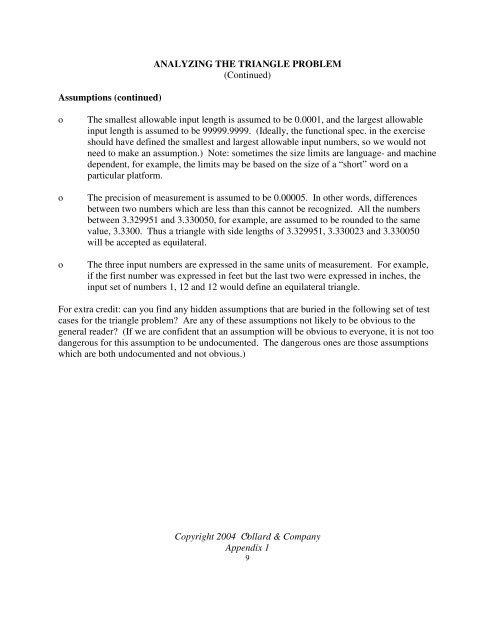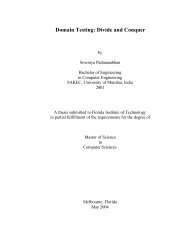appendix 1. analyzing the triangle problem - Testing Education
appendix 1. analyzing the triangle problem - Testing Education
appendix 1. analyzing the triangle problem - Testing Education
You also want an ePaper? Increase the reach of your titles
YUMPU automatically turns print PDFs into web optimized ePapers that Google loves.
Assumptions (continued)<br />
ANALYZING THE TRIANGLE PROBLEM<br />
(Continued)<br />
o The smallest allowable input length is assumed to be 0.0001, and <strong>the</strong> largest allowable<br />
input length is assumed to be 99999.9999. (Ideally, <strong>the</strong> functional spec. in <strong>the</strong> exercise<br />
should have defined <strong>the</strong> smallest and largest allowable input numbers, so we would not<br />
need to make an assumption.) Note: sometimes <strong>the</strong> size limits are language- and machine<br />
dependent, for example, <strong>the</strong> limits may be based on <strong>the</strong> size of a “short” word on a<br />
particular platform.<br />
o The precision of measurement is assumed to be 0.00005. In o<strong>the</strong>r words, differences<br />
between two numbers which are less than this cannot be recognized. All <strong>the</strong> numbers<br />
between 3.329951 and 3.330050, for example, are assumed to be rounded to <strong>the</strong> same<br />
value, 3.3300. Thus a <strong>triangle</strong> with side lengths of 3.329951, 3.330023 and 3.330050<br />
will be accepted as equilateral.<br />
o The three input numbers are expressed in <strong>the</strong> same units of measurement. For example,<br />
if <strong>the</strong> first number was expressed in feet but <strong>the</strong> last two were expressed in inches, <strong>the</strong><br />
input set of numbers 1, 12 and 12 would define an equilateral <strong>triangle</strong>.<br />
For extra credit: can you find any hidden assumptions that are buried in <strong>the</strong> following set of test<br />
cases for <strong>the</strong> <strong>triangle</strong> <strong>problem</strong>? Are any of <strong>the</strong>se assumptions not likely to be obvious to <strong>the</strong><br />
general reader? (If we are confident that an assumption will be obvious to everyone, it is not too<br />
dangerous for this assumption to be undocumented. The dangerous ones are those assumptions<br />
which are both undocumented and not obvious.)<br />
Copyright 2004 Collard 9 & Company<br />
Appendix 1<br />
9








